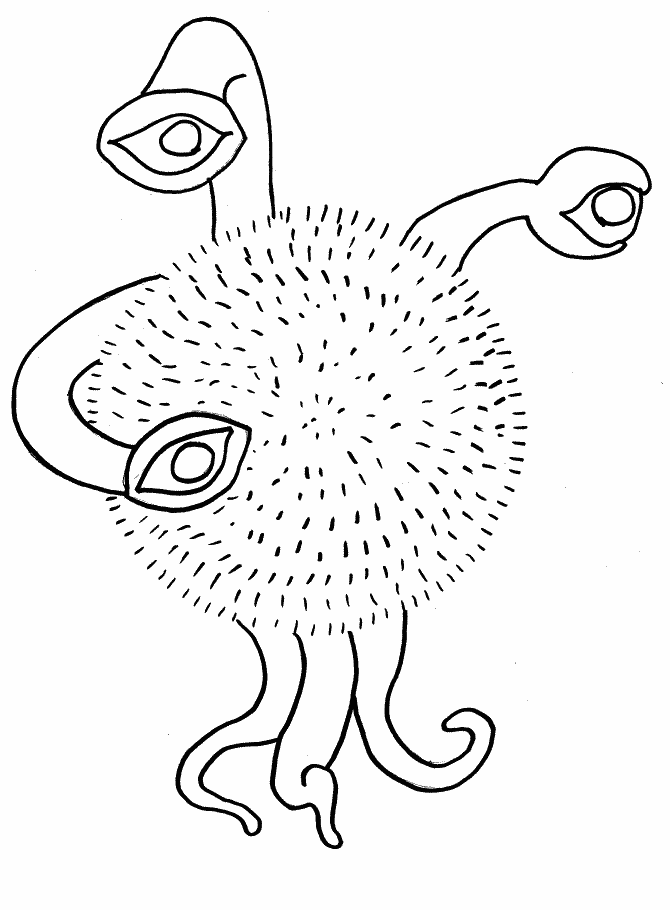Rendezvous
with a
Comet
A Sample
The Process
Design a Space Alien
A Sample
| Report | Design a Space Alien ~ prepared by Terry, Shaukat, Carl, and Nellie ~ |
| The Problem | We are members of a research team who have been given the task of trying to find out what aliens living on distant planets might look like, and how they have adapted to their environments. This might give scientists on trips to far away worlds an idea of how best to prepare to encounter and perhaps speak with space aliens. |
The Planet
|
Planet Zirkon is a dwarf planet. It is part of the group represented by Ceres, Pluto, Charon, and Xena. Zirkon was not discovered until the year 2023 when a satellite circling the Sun found it. Zirkon is strange in that its orbit is nearly identical to that of planet Earth. It orbits the sun precisely opposite the Earth as seen from the Sun. It takes one year to orbit the Sun, just like Earth. Because of this, Zirkon can never be seen from Earth. Zirkon is not quite round. Like the moon does with the Earth, the same side of Zirkon always points toward the Sun in something known as tidal locking. Because of this, one side of Zirkon is always day, and the other side is always night. The day side is quite warm; the night side quite cool - and even has a permanent ice pack at the point opposite the Sun! Fortunately, strong ocean currents flowing between the day to night sides keeps the dark side relatively warm, but not much above the freezing point of water. Most of the life on this dwarf planet lives under its ocean. Zirkon is small - about the size of Mars. Because it is small and near enough to the Sun to be quite warm on the average, it does not have much of an atmosphere. The atmosphere is made up of mostly carbon dioxide, oxygen, and water vapor. It has several large but dry land masses, and parts are covered with a green moss. Its oceans are blue, just like on Earth, but the ice pack on the dark side is blue-green! Clearly, the oceans are not made out of water. |
Space Alien
|
Accommodations We have called our space alien "Sponge Bobbie" because she lives under the oceans of Zirkon and is a girl. Sponge Bobbie is soft and has three really big eyes. She also has three legs or tentacles that she can use to hold on to rocks at the bottom of the Zirkon's ocean. You will recall, Zirkon has strong ocean currents moving between the day and night sides of the planet. Our space alien has big eyes because when she goes to the night side of the planet to hunt for food or cool off, it is always dark there. The big eyes help Sponge Bobbie see better under the weak light coming only from the planets and stars. Remember, Zirkon keeps one side constantly facing the sun and so has continuous day and night on opposite sides of the planet. Sponge Bobbie can "speak" with her friends by pulsing her sponge-like body just like a speaker on a radio or sound system. When she wants to make a high pitched squeak, she vibrates the central part of her body very quickly. If she wants to make a low pitched rumble, she vibrates very slowly. If she wants to get loud, she vibrates very strongly; if she wants to make a soft sound, she vibrates very weakly. Sponge Bobbie can be heard from many miles away under the oceans of Zirkon. She does not move to land, because she would collapse, dry out, and die. Sponge Bobbie has no bones, and must be supported by water just like a jellyfish. Our space alien can both taste and smell by circulating fluids through her sponge-like body. She can hear in the same way she produces sounds, but in reverse. Sensors for feeling are all over the being's body, just like with humans. These space aliens don't have any special senses beyond those of humans. |
| References | "Space Life," available http://ais.edu/, accessed March 13, 2067. "Life on the Edge," available http://cicc.arizona.edu/, accessed March 13, 2067. "What's a Space Alien?" by Theodore McBride, McNally & Port Publishers, New York, 2059. "Life in Space" a television show on XYZ TV viewed March 3, 2067 "Comet Halley and Planet Zirkon" by Fran Stankevitz, Zeller & Minor Publishing, Baltimore, MD, 2060. |
 |
Support for program number HST-ED-90285.01-A was provided by NASA through a grant from the Space Telescope Science Institute, which is operated by the Association of Universities for Research in Astronomy, Incorporated, under NASA contract NAS5-26555. Copyright (c) 2007 Challenger Learning Center at Prairie Aviation Museum and Challenger Learning Center of Northwest Indiana. Staff of Challenger Learning Centers and instructors of classes involved with Challenger Learning Center missions may reproduce this WebQuest guide for classroom and educational purposes. Otherwise this work may not be reproduced, stored in a retrieval system, or transcribed, in any form or by means – electronic, mechanical, photocopying, recording, or otherwise – without the prior written permission of the copyright owners. This page is based upon the WebQuest model. |










 Sponge Bobbie
Sponge Bobbie